Photo

Boys wave as they ride in the trunk of a car February 19, 2004 in Baghdad, Iraq. (Photo by Mario Tama/Getty Images) #
33K notes
·
View notes
Text

Illustration from kink mag: Rubberist no. 28
archived by D.D. Teoli Jr. A.C.
2 notes
·
View notes
Text

PLUR Rave flyer 1998
2 notes
·
View notes
Text




...more 90s Midwest Rave flyers
3 notes
·
View notes
Text




90s Midwest Rave flyers
0 notes
Text
youtube
" The moon was shining, and it drew my attention.
He showed me that animal, on that ring around the moon.
I was playing out in the streets,
'cause i wasnt old enough to go to school.
Children said, 'Minnie, what are you looking at?'
I said 'I'm looking at those elephants going around the moon .'
They laughed at me, 'Minnie's crazy, we don't see no elephants'
I thought everybody could see them.
I wasn't like the other children.
One night I had a dream
This voice spoke to me
'Why dont you draw, or die'
I said 'is that it?
My.' "
-Minnie Evans
#minnie evans#black american art#folk art#blakc art#african american art#art history#american visionary art museum#black painter#Youtube
4 notes
·
View notes
Text
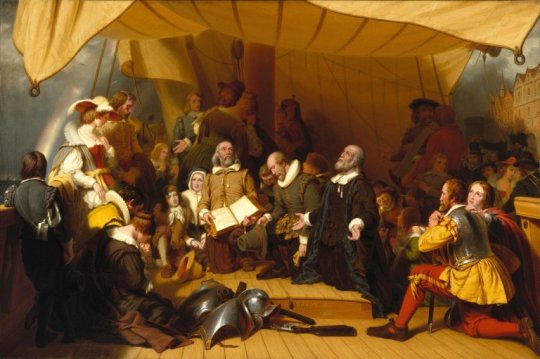
Embarkation of the Pilgrims. Robert Walter Weir. date 1857
"One of the works exhibited in the Philadelphia Centennial exhibition in 1876, this midcentury painting documented a tearful group of English Puritans departing from their temporary home in Holland aboard the Speedwell, a ship that was to accompany the Mayflower to New England. Robert Weir based the picture on documentary evidence—written accounts, histories, and costume records—to enhance the authenticity of the early memorial to colonial history."
* The Pilgrims later left Speedwell behind and sailed in the Mayflower.
Authors note: BEFORE THE MAYFLOWER...The colonizers were aboard the Speedwell, before they were American.
Depicted in this painting as so-called-godly people, rife with disease to spread and genocide, the word of God in hand and on tongue, to be spit like bile-scorching the new earth their feet touched. They, however, believed, it was, I would go so far as to say, their 'birthright'...
Brooklyn Museum
5 notes
·
View notes
Text

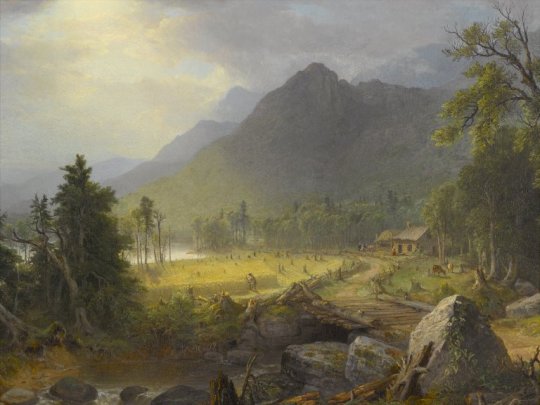
The First Harvest in the Wilderness Asher B. Durand. 1855
"Asher B. Durand’s composition depicts an expanse of rugged terrain and forests under stormy skies. This American wilderness yields to progress as a lone farmer reaps his first harvest in a field, still dotted with the stumps of recently cleared trees and gleaming under a sudden shaft of light that penetrates the heavy clouds. A boulder resting by the side of the road identifies our glorified pioneer by name as “Graham.” Using funds bequeathed by one of its founders, Augustus Graham, the Museum commissioned Durand to paint this work in 1855, thus officially establishing its collection of American art. Durand’s dramatic landscape pays tribute to Graham’s efforts as a cultural pioneer."
Brooklyn Museum
authors note: this reminds me of the show "Alone", and the conception of "wilderness" in its relationship to settler colonial conceptions of land (resources), and "mans" domain of/over land. I am also reminded of the many people I work with/around, living rurally and working on a farm-in place dominated by British Loyalist Settlers.
#asher b durand#oil painting#1800s art#manifest destiny#settler colonialism#colonization#brooklyn museum#brooklyn
0 notes
Text

Mano Poderosa (The All-Powerful Hand), or Las Cinco Personas (The Five Persons) 19th century
medium: possible painted tine-plated-iron
"Perched on the tips of the fingers of a detached hand, Christ appears flanked by his parents and his grandparents, Anna and Joachim. The symbol of the hand, deriving from the European cult of Saint Anne, also bears the wound of the stigmata in reference both to the Crucifixion and to the life of Saint Francis; the seven lambs, drinking here from the chalice of Christ's blood, derive from the Book of Revelations."
Authors Note: The artist listed for this piece in the Brooklyn Museum Archives is simply 'Mexican', no recorded name. This piece was purchased by the Museum with funds given by the estate of Warren S.M. Mead.
4 notes
·
View notes
Text

Soul in Bondage. Elihu Vedder. oil painting. 1891-1892
"In this brooding Symbolist subject titled Soul in Bondage, the American expatriate Elihu Vedder brought together his key interests in idealized human form, abstracted design, and the themes of internal spiritual conflict. Profoundly inspired by the writer Edward Fitzgerald's translation of mystical Persian verse in the Rubáiyát of Omar Khayyám (Vedder illustrated a lush 1884 edition), he created numerous subjects representing the individual bound by the dilemma of choice between good and evil symbolized here by the butterfly and the serpent. Behind the figure Vedder employed his signature "double swirl," a motif he had used repeatedly in the Rubáiyát illustrations to suggest the forces that converge and then disperse around the brief point that constitutes an individual human life."
Brooklyn Museum
Authors Note: The environment of the figure makes them look huge, sitting atop rolling hills that exist in a realm in the sky, further illustrated by the lines emanating from the loop surrounding the figure, receding into the distance in a spiral, further suggesting the infinity. The figure is also holding a butterfly and a snake...
This Persian to English selection of quatrains (rubāʿiyāt) are attributed to Ghiyāth al-Dīn Abū al-Fatḥ ʿUmar ibn Ibrāhīm Nīsābūrī a.k.a Omar Khayyam (1048–1131), dubbed "the Astronomer-Poet of Persia".
#elihu vedder#1800s art#american painter#oil painting#painting#american art#quatrain#omar khayyam#edward fitzgerald
4 notes
·
View notes
Text
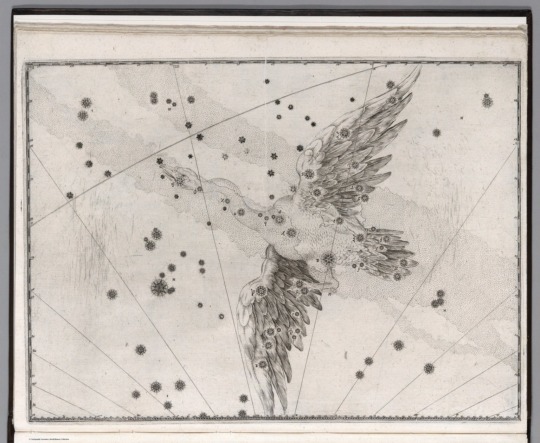
Constellation: Cygnus, the Goose Bayer, Johann (1572-1625)
Publication date 1655
51 unfolded engraved plates of celestial constellations by Alexander Mair. The very rare fourth edition of Bayer's Uranometria (first published in 1603), the first atlas to cover the entire celestial sphere, in fifty-one star charts, including one containing twelve new constellations unknown to Ptolemy. The illustrations are based on Jacob de Gheyn's designs for the Grotius edition of Aratus, published in Leiden in 1600. Johann Bayer (1572-1625) practised as a lawyer in Augsburg, but his principal interest was in the rapidly developing field of astronomy. His most important innovation was a new system of identifying all stars (prior to the invention of the telescope) by Greek and Roman letters, known today as the Bayer designation. The 1655 edition is much rarer than the 1661 edition" (Milestones of Science Books). "Bayer's was the first accurate star atlas. Earlier star catalogues followed Ptolemy's Almagest in using verbal descriptions to describe the location of stars within the 48 northern constellations of classical astronomy, an awkward system that occasioned constant errors and misapprehensions. Bayer, a lawyer and amateur astronomer, was the first to identify the location of stars within a constellation by the use of Greek letters (with the addition of the Latin alphabet for constellations with more than 24 stars). This simple innovation greatly facilitated the identification of stars with the naked eye, just five or six years before the invention of the telescope, and Bayer's stellar nomenclature is still in use today. Bayer used Brahe's recent observations for the northern sky, and included, in chart 49, twelve new southern constellations observed by the Dutch navigator Pieter Dirckzoon Keyzer and reported by Pedro de Medina. To simplify identification of the stars Bayer included in his typographic descriptions both the traditional star numerations within each constellation and the many names for the constellations employed since Ptolemy (Christies). The Uranometria was reprinted in 1639, 1648, 1655 (this copy) and 1661. Constellations largely identified by cataloger.
Deborah Warner, The sky explored: celestial cartography 1500-1800 pp. 18-19
Found in the David Rumsey Map Collection
#astronomy#astro observations#illustration#stars#star map#map#johann bayer#celestial#david rumsey#archive
18 notes
·
View notes
Text

Wharf Laborer's (1920-30s)
"This photograph is part of the Australian National Maritime Museum's collection of nitrate negatives taken by Harold Nossiter and his son Harold Nossiter Junior in the 1920s and 1930s. Harold Nossiter (senior) was a noted Sydney sailor in the 1920s and 1930s who became the first Australian to skipper a yacht around the world under an Australian flag. The images in the collection depict the people, places and vessels encountered by the Nossiter family as they sailed on yachts UTIEKAH II along the NSW coast, and SIRIUS during the world cruise. "
1 note
·
View note
Text

Unknown House in Keene New Hampshire (1900-20?)
#new hampshire#black and white photography#film#creepy aesthetic#internetarchive#americana#american gothic
4 notes
·
View notes
Text

Sketch of alien planet landscape
Publication date 2011-03-07
Description: Sketch of alien planet landscape sent to the Ministry of Defence.
Date: January 2004
Artist: Unknown
9 notes
·
View notes
Text

Close up of light in sky, Sri Lanka
"Photograph of ''an unusual atmospheric atmospheric occurrence observed over Sri Lanka'' forwarded to the Ministry of Defence by RAF Fylingdales. Date: 27th March 2004 "
1 note
·
View note
Text
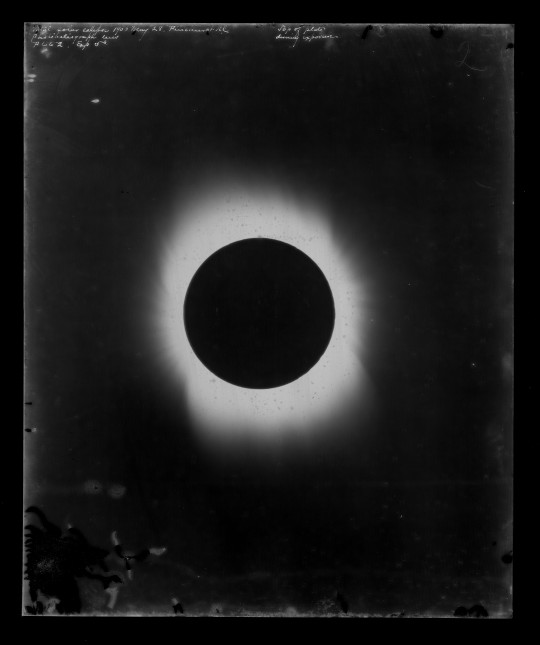
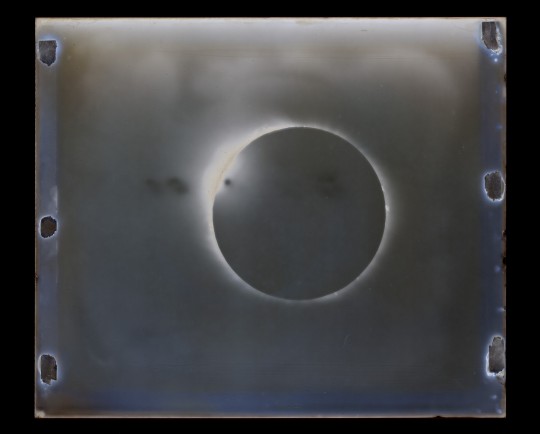
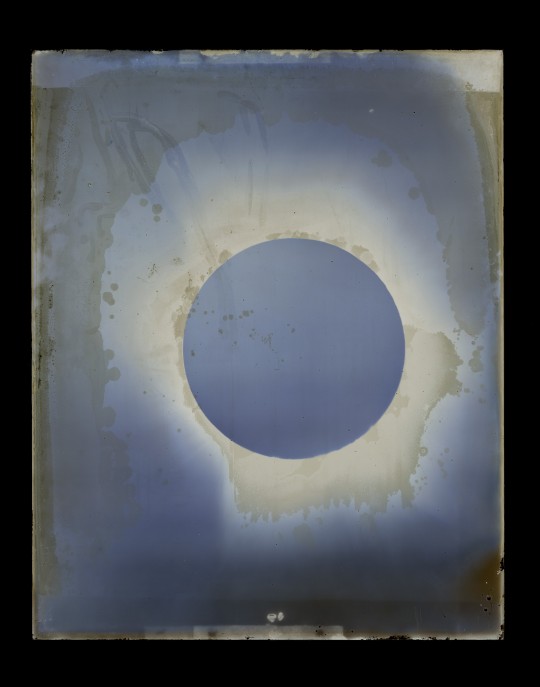



Digitized plates of solar eclipses from the United States Naval Observatory Library & Archives
Locations and years of eclipses:
Pinehurst, North Carolina. May 28, 1900
Limerick, Maine. August 31, 1932
Iloilo, The Philippines. May 9, 1929
Guelma, Algeria. August 30, 1905
Fort De Kock, Sumatra. May 17, 1901
Barnesville, Georgia. May 28, 1900
#astronomy#solar eclipse#archive#space#moon#United States Naval Observatory#astronomical photography#glass plate negative#internetarchive
2K notes
·
View notes
Text


Tatung Einstein Computer
Amstrad CPC 6128
101 notes
·
View notes